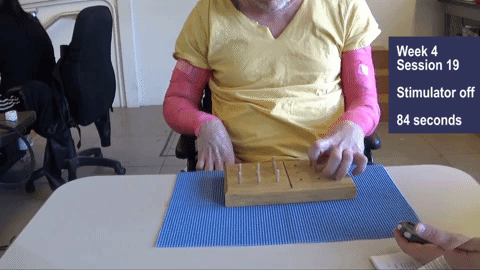
Upper extremity function is the highest priority of tetraplegics for improving quality of life. We aim to determine the therapeutic potential of transcutaneous electrical spinal cord stimulation for restoration of upper extremity function. We tested the hypothesis that cervical stimulation can facilitate neuroplasticity that results in long-lasting improvement in motor control. A 62-year-old male with C3, incomplete, chronic spinal cord injury (SCI) participated in the study. The intervention comprised three alternating periods: 1) transcutaneous spinal stimulation combined with physical therapy (PT); 2) identical PT only; and 3) a brief combination of stimulation and PT once again. Following four weeks of combined stimulation and physical therapy training, all of the following outcome measurements improved: the Graded Redefined Assessment of Strength, Sensation, and Prehension test score increased 52 points and upper extremity motor score improved 10 points. Pinch strength increased 2- to 7-fold in left and right hands, respectively. Sensation recovered on trunk dermatomes, and overall neurologic level of injury improved from C3 to C4. Most notably, functional gains persisted for over 3 month follow-up without further treatment. These data suggest that noninvasive electrical stimulation of spinal networks can promote neuroplasticity and long-term recovery following SCI.

